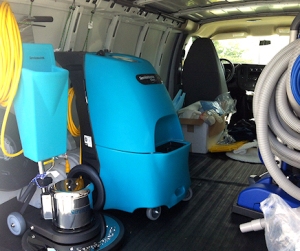|

Hot Water Extraction vs. Interim Maintenance Cleaning
What Are The Differences – Why Do They Both Work?
When your carpets are being cleaned, the most important thing to remember is that it is not a matter of using one method or the other, but both combined in a maintenance program to achieve the desired results and follow warranty requirements. Interim cleaning generally cleans the top 30% of the carpet fibers removing spots and stains, and hot water extraction cleaning includes the bottom 70%Interim cleaning is considered a more frequent and necessary step by carpet manufacturers, while hot water extraction is required less often and considered restorative. Use of both interim and restorative cleans is mandatory to keep a carpet warranty valid. This is because used together, they are very effective; much more so than when just one method is used alone.
You, or building managers and strata members may wonder, what are the differences? What should be expected when they see each method of cleaning being performed? The following breakdown will hopefully provide some necessary insight as to what is being done in order to properly maintain your carpet, extend its’ lifespan, and keep the warranty valid.
 Rotary Method – Interim Maintenance Clean Rotary Method – Interim Maintenance Clean
Cost Per Visit: Less than hot water extraction, typically 1/3 to 1/2 of the price.
Frequency: 3x per year based on the amount of foot traffic typically found in residential strata buildings.
Time To Perform: 1/3 to 1/2 of the time when compared to hot water extraction, depending upon the condition of the carpet.
What this looks like: The technician will inspect the carpet and pre-spray spots and stains with appropriate cleaning agent, 5 – 10 minutes at least before cleaning the area with the rotary machine. He may pre-spray the entire length of the common area with a more general soil lifting agent prior to cleaning the carpets.
After the cleaning agent has some time to suspend the soil, he will clean the area with the rotary machine, which I would compare to moving like a lawnmower; it is pushed down the halls in a side to side motion, scrubbing the top 30% of the carpet fibers removing dirt and stains. This method is especially effective against greasy or oily stains.
The pads which are used to do this cleaning, are flipped and changed as necessary to ensure carpet is being cleaned effectively. They are washed in a washing machine prior to reuse.
It should be noted that stairs cannot be cleaned with this interim method.
Drying Time: Minimal to none. Since there is no hot water being injected into the carpet fibers as would be done with a restorative hot water extraction cleaning, some areas may feel damp immediately afterward where pre-spraying spots was necessary, where other areas may feel dry to the touch. The spinning action of the dry pad pulls the soil and cleaning agent previously applied quickly from the carpet fibers and wicking finishes drying time almost immediately.
Result: Spots and stains should be removed, carpet is cleaner. Top 30% of the carpet fibers have been serviced. On carpet with longer fibers, there may be swirl marks from the rotary motion which will disappear as people walk on the carpet, or once it has been vacuumed. Technicians have reported that this is the best method for getting most visible stains out of carpet.
Hot Water Extraction – Also Known As Steam Cleaning or Restorative Cleaning

Cost Per Visit: Most expensive type of carpet cleaning, 2x – 3x that of interim rotary cleaning
Frequency: 1x per year in typical high traffic areas of residential strata buildings, based on foot traffic. Some buildings where tenants do not take as much care with the carpets may require more frequent cleanings, especially in problem areas. These typically include outside elevators, main entrances, stairs to parking areas, etc.
Time to Perform: slower than maintenance cleaning, as the technician must methodically move the wand by hand in patterns to ensure this cleaning method is working most effectively. Time must be taken to remove the hot water injected into the carpet. Usually this takes approximately 2x as long.
What this looks like: A properly trained technician will use a truck mounted cleaning system or high powered portable to clean the carpets. It involved a pre-conditioning phase to emulsify soil (pre-spraying), and an injection extraction rinse phase that remove the soil.
The technician will pre-spray spots and stains, and then use either the wand connected to the truck mount unit or the high powered portable, to inject and remove hot water from the carpet, sucking up the soil so that it may be disposed of.
Drying Time: this can vary greatly, depending on air flow, humidity in the air, what the carpet is made of, and the experience of the technician. Properly trained professionals can ensure they do not over wet a carpet, which can result in extended drying time and possible damage to the carpet. 6-8 hours is optimal. Open windows and doors to increase air flow and hasten drying time, which can be as little as 2 hours.
Results: Spots and stains removed, bottom 70% of the carpet fibers are cleaned as well as the top 30%. Best restorative method for heavily soiled carpets. Carpets with longer fibers may show a pattern from the cleaning wand being moved across the carpet. This will disappear as it is walked on or vacuumed. It may not be visible at all on short fiber carpets.
No individual cleaning method can be accurately described as best for every carpet in every situation. Each has its’ place in the overall picture of carpet maintenance. However, both methods combined with frequent vacuuming and spot removal are necessary to keep a carpet warranty valid. |